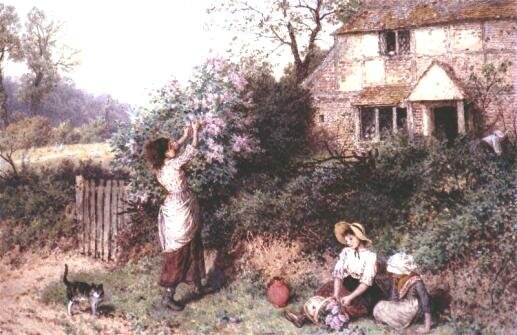|
|
|
 |
Gathering Lilac
By Myles Birket Foster
The painting has been acquired with financial backing from the National Art Collections fund, The Hamamelis Trust and generous private donors. It can now be seen in the
Gertrude Jekyll room at the Godalming Museum |
Myles Birket Foster
RWS RAB (Berlin) (1825 - 1899)
Born in North Shields, Birket Foster moved to Tottenham when he was five. After a Quaker education, he began his career drawing on woodblock for prints in the Illustrated London News and Punch. He became self-employed at the age of twenty-one and worked as an illustrator, particularly of poetry books. In the late 1850s, he turned to painting in watercolour. He taught himself in the fields around Dorking, his initial style being a development of his highly detailed drawings. In the early 1860s, he was elected to the Royal Watercolour Society and moved out of London to Witley, near Godalming, in Surrey.
He designed his new house 'The Hill', himself. He and his family lived there until 1893, when ill health forced him to move to a smaller house in Weybridge. Birket Foster consulted William Morris about the interior decoration of 'The Hill' and filled it with paintings and other works by his fellow artists, including a frieze, stained glass and tiles by Burne-Jones.
In Witley, Birket Foster was at the centre of a thriving artistic colony which included George Eliot, Kate Greenaway and Helen Allingham. For 30 years he was a notable local character, important in the life of the village as well as to his fellow artists. He gloried in laying on elaborate amateur theatricals, to which all of his employees and most of the village were invited. He painted a new sign for the local pub, the White Hart. 'The Hill' was known for its enormous Christmas parties and musical entertainments. The Foster family also left their mark on the village in more substantial ways. Birket Foster's brother John paid for the restoration of the parish church and built the village Institute.
Frederick Walker, who was a frequent visitor to 'The Hill', described the countryside around Witley as 'Paradise'. Its scenes of country life inspired Birket Foster's popular and widely admired watercolours. Among others, his work influenced that of Helen Allingham, whose watercolour 'The South Border at Munstead Wood' is on display in the Museum.
'Gathering Lilac' shows a traditionally built Surrey cottage, with a woman working in the garden and three girls picking lilacs on the verge of a country lane. Geese feed on the common, with wooded hills rising behind. It is a vision of picturesque and contented country life which was shared by many in the Arts and Crafts movement, including local architect Sir Edwin Lutyens and garden designer Gertrude Jekyll. Birket Foster is buried in Witley Churchyard.
|
